Factors Influencing the Thermal Efficiency of Horizontal Ground Heat Exchangers
Abstract
:1. Introduction
2. Materials and Methods
2.1. Test Site
- (1)
- fine sand 0–1 mm (fs);
- (2)
- fine sand 0–1 mm with 15% bentonite (fs15B);
- (3)
- a commercial product (GeoSolid 240HS) in direct contact with the Helix, in turn surrounded by sand 0–5 mm (s);
- (4)
- sand 0–5 mm + 15% bentonite (s15B);
- (5)
- loamy sand (SC);
2.2. The Monitoring System
- the ground temperature inside and outside each helix (six sensors/helix, 30 sensors in total);
- the undisturbed ground and surface temperature (two sensors) outside the trench;
- the fluid temperature running in and out the helix system (two sensors);
- the speed flow inside the helix (one sensor);
- the speed flow between the helix and the absorber (four sensors);
- the surface temperature of the absorber (two sensors);
- the volumetric water content (VWC) at 0.60 m depth, that is at the top of each helix (five sensors).
- (1)
- at the helix inlet (A), at 0.80 m depth below the ground surface (bgl) and 4 m away from the east (E) margin;
- (2)
- at the helix center (B), at 0.80 m depth (bgl) and 2.5 m away from E margin;
- (3)
- at the helix end (C), at 0.80 m depth (bgl) and 1 m away from E margin;
- (4)
- at the helix end (D) at 0.80 m depth (bgl) and 0.5 m away from E margin;
- (5)
- at the helix center (E), at 0.40 m depth (bgl) and 2.5 m away from E margin;
- (6)
- at the helix center (F), at 0.30 m depth (bgl) and 2.5 m away from E margin;
- (7)
- outside the test site (Tground), near the datalogger, at 0.60 m depth (bgl);
- (8)
- outside the test site (Tsurf), near the datalogger, at 0.10 m depth (bgl).
3. Results and Discussions
3.1. Metereological Variables
3.2. Soil Temperatures
- TD never drops below 0 °C when the heat pump is running, showing a mean value of about 4.5, 5.2, 4.3, 4.7, 4.5 °C in sector 1-2-3-4-5 respectively;
- TB average values of about −5.3, −5.2, −4.0, −5.0 °C for (fs), (fs15B), (s), (s15B) sectors are determined. No direct measurements are available for loamy sand (SC) sector, due to sensor B malfunction, but a value of about 5 °C is considered to be plausible;
- Tground shows a mean value of about 5.2 °C;
- Tsurf has a mean value of 2.5 °C
3.3. Thermal Conductivity and Moisture Content Variation
4. Conclusions
Acknowledgments
Author Contributions
Conflicts of Interest
Nomenclature
| VSGs | very shallow geothermal systems |
| RHC | Renewable Heating & Cooling |
| GSHPs | Ground Source Heat Pumps |
| λ | heat conductivity (W m−1 K−1) |
| TEBM | thermally enhanced backfilling materials |
| XPS | extruded polystyrene |
| fs | fine sand 0–1 mm |
| fs15B | fine sand 0–1 mm with 15% bentonite |
| s | sand 0–5 mm |
| GS | GeoSolid 240HS |
| s158 | sand 0–5 mm + 15% bentonite |
| SC | loamy sand |
| VWC | volumetric water content (%) |
| bgl | below the ground level |
| T | temperature |
| TS | temperatures |
| Tground | temperature of the ground outside the test site at 0.60 m depth (°C) |
| Tsurf | temperature of the ground surface outside the test site (° C) |
| Tair_2m | temperature of the air 2 m above the ground surface (°C) |
| Tair_surf | temperature of the air above the soil surface (°C) |
| Tairf | temperature of the atmospheric air (°C) |
| BX | sensor B in each sector |
| DX | sensor D in each sector |
| TA-B-C-D-E-F | temperature measured at sensor A, B, C, D, E, F respectively |
| MC | moisture content detected in situ with TDR device |
| TDR | Time Domain Reflectometry |
References
- EU Energy Roadmap. Available online: http://ec.europa.eu/energy/energy2020/roadmap/index_en.htm (accessed on 29 September 2017).
- Self, S.J.; Reddy, B.V.; Rosen, M.A. Geothermal heat pump systems: Status review and comparison with other heating options. Appl. Energy 2013, 101, 341–348. [Google Scholar] [CrossRef]
- RHC-Platform. Strategic Research and Innovation Agenda for Renewable Heating and Cooling. 2013, pp. 1–116. Available online: http://www.rhc-platform.org/fileadmin/user_upload/members/RHC_SRA_0418_lowres.pdf (accessed on 30 September 2017).
- Di Sipio, E.; Galgaro, A.; Destro, E.; Teza, G.; Chiesa, S.; Giaretta, A.; Manzella, A. Subsurface thermal conductivity assessment in Calabria (southern Italy): A regional case study. Environ. Earth Sci. 2014, 72, 1383–1401. [Google Scholar] [CrossRef]
- Sanner, B.; Karytsas, C.; Mendrinos, D.; Rybach, L. Current status of ground source heat pumps and underground thermal energy storage in Europe. Geothermics 2003, 32, 579–588. [Google Scholar] [CrossRef]
- Adaro, J.A.; Galimberti, P.D.; Lema, A.I.; Fasulo, A.; Barral, J.R. Geothermal contribution to greenhouse heating. Appl. Energy 1999, 64, 241–249. [Google Scholar] [CrossRef]
- D’Arpa, S.; Colangelo, G.; Starace, G.; Petrosillo, I.; Bruno, D.E.; Uricchio, V.; Zurlini, G. Heating requirements in greenhouse farming in southern Italy: Evaluation of ground-source heat pump utilization compared to traditional heating systems. Energy Effic. 2015, 9, 1065–1085. [Google Scholar] [CrossRef]
- Omer, A.M. Ground-source heat pumps systems and applications. Renew. Sustain. Energy Rev. 2008, 12, 344–371. [Google Scholar] [CrossRef]
- Schelenz, S.; Vienken, T.; Shao, H.; Firmbach, L.; Dietrich, P. On the importance of a coordinated site characterization for the sustainable intensive thermal use of the shallow subsurface in urban areas: A case study. Environ. Earth Sci. 2017, 76, 73. [Google Scholar] [CrossRef]
- Bi, Y.; Wang, X.; Liu, Y.; Zhang, H.; Chen, L. Comprehensive exergy analysis of a ground-source heat pump system for both building heating and cooling modes. Appl. Energy 2009, 86, 2560–2565. [Google Scholar] [CrossRef]
- Galgaro, A.; Di Sipio, E.; Teza, G.; Destro, E.; De Carli, M.; Chiesa, S.; Zarrella, A.; Emmi, G.; Manzella, A. Empirical modeling of maps of geo-exchange potential for shallow geothermal energy at regional scale. Geothermics 2015, 57, 173–186. [Google Scholar] [CrossRef]
- Florides, G.; Kalogirou, S. Ground heat exchangers—A review of systems, models and applications. Renew. Energy 2004, 32, 2461–2478. [Google Scholar] [CrossRef]
- Han, C.; Ellett, M.K.; Naylor, S.; Yu, X.B. Influence of Local Geological Data on the Performance of Horizontal Ground coupled Heat Pump System Integrated with Building Thermal Loads. Renew. Energy 2017, 113, 1046–1055. [Google Scholar] [CrossRef]
- Banks, D. An Introduction to Thermogeology: Ground Source Heating and Cooling; John Wiley & Sons, Ltd.: New York, NY, USA, 2012. [Google Scholar]
- Busby, J.; Lewis, M.; Reeves, H.; Lawley, R. Initial geological considerations before installing ground source heat pump systems. Q. J. Eng. Geol. Hydrogeol. 2009, 42, 295–306. [Google Scholar] [CrossRef]
- Zhang, W.; Yang, H.; Lu, L.; Fang, Z. Investigation on heat transfer around buried coils of pile foundation heat exchangers for ground-coupled heat pump applications. Int. J. Heat Mass Tranf. 2012, 55, 6023–6031. [Google Scholar] [CrossRef]
- Lee, C.K. Dynamic performance of ground-source heat pumps fitted with frequency inverters for part-load control. Appl. Energy 2010, 87, 3507–3513. [Google Scholar] [CrossRef]
- Galgaro, A.; Farina, Z.; Emmi, G.; Carli, M.D. Feasibility analysis of a borehole heat exchanger (BHE) array to be installed in high geothermal flux area: The case of the Euganean thermal basin, Italy. Renew. Energy 2015, 78, 93–104. [Google Scholar] [CrossRef]
- Wu, Y.; Gan, G.; Verhoef, A.; Vidale, P.L.; Gonzalez, R.G. Experimental measurement and numerical simulation of horizontal-coupled slinky ground source heat exchangers. Appl. Therm. Eng. 2010, 30, 2574–2583. [Google Scholar] [CrossRef]
- Naili, N.; Attar, I.; Hazami, M.; Farhat, A. Experimental Analysis of Horizontal Ground Heat Exchanger for Northern Tunisia. J. Electron. Cool. Therm. Control. 2012, 2, 44–51. [Google Scholar] [CrossRef]
- Neuberger, P.; Adamovsky, R.; Sed’ova, M. Temperatures and heat flows in a soil enclosing a slinky horizontal heat exchanger. Energies 2014, 7, 972–987. [Google Scholar] [CrossRef]
- Chong, C.S.A.; Gan, G.; Verhoef, A.; Gonzalez, R.G.; Vidale, P.R. Simulation of thermal performance of horizontal slinky-loop heat exchangers for ground source heat pumps. Appl. Energy 2013, 104, 603–610. [Google Scholar] [CrossRef]
- Demir, H.; Koyun, A.; Temir, G. Heat transfer of horizontal parallel pipe ground heat exchanger and experimental verification. Appl. Therm. Eng. 2009, 29, 224–233. [Google Scholar] [CrossRef]
- Benazza, A.; Blanco, E.; Aichouba, M.; Río, J.L.; Laouedja, S. Numerical Investigation of Horizontal Ground Coupled Heat Exchanger. Energy Procedia 2011, 6, 29–35. [Google Scholar] [CrossRef]
- Kharseh, M.; Altorkmany, L. How global warming and building envelope will change buildings energy use in central Europe. Appl. Energy 2012, 97, 999–1004. [Google Scholar] [CrossRef]
- Congedo, P.M.; Colangelo, G.; Starace, G. CFD simulations of horizontal ground heat exchangers: A comparison among different configurations. Appl. Therm. Eng. 2012, 33, 24–32. [Google Scholar] [CrossRef]
- Starace, G.; Congedo, P.M.; Colangelo, G. Horizontal heat exchangers for GSHPs. Efficiency and cost investigation for three different applications. In Proceedings of the 18th International Conference on Efficiency, Cost, Optimization, Simulation, and Environmental Impact of Energy Systems, Trondheim, Norway, 20–23 June 2005; pp. 1443–1450. [Google Scholar]
- Zarrella, A.; De Carli, M. Heat transfer analysis of short helical borehole heat exchangers. Appl. Energy 2013, 102, 1477–1491. [Google Scholar] [CrossRef]
- Zarrella, A.; Emmi, G.; De Carli, M. Analysis of operating modes of a ground source heat pump with short helical heat exchangers. Energy Convers. Manag. 2015, 97, 351–361. [Google Scholar] [CrossRef]
- Zarrella, A.; Emmi, G.; Graci, S.; De Carli, M.; Cultrera, M.; Dalla Santa, G.; Galgaro, A.; Bertermann, D.; Mueller, J.; Pockelé, L.; et al. Thermal Response Testing Results of Different Types of Borehole Heat Exchangers: An Analysis and Comparison of Interpretation Methods. Energies 2017, 10, 801. [Google Scholar] [CrossRef]
- Farouki, O.T. Thermal Properties of Soils (No. CRREL-MONO-81-1); Cold Regions Research and Engineering Lab: Hanover, NH, USA, 1981; Available online: http://www.dtic.mil/docs/citations/ADA111734 (accessed on 17 November 2017).
- Drefke, C.; Schedel, M.; Stegner, J.; Balzer, C.; Hinrichsen, V.; Sass, I. Measurement Method of Thermal Properties of Cementitious Bedding Materials and Unsaturated Soils: Hydraulic Influence on Thermal Parameters. Geotech. Test J. 2016, 40, 160–170. [Google Scholar] [CrossRef]
- Bertermann, D.; Klug, H.; Morper-Busch, L. A pan-European planning basis for estimating the very shallow geothermal energy potentials. Ren. Energy 2015, 75, 335–347. [Google Scholar] [CrossRef]
- Gonzalez, R.G.; Verhoef, A.; Vidale, P.L.; Main, B.; Gan, G.; Wu, Y. Interactions between the physical soil environment and a horizontal ground coupled heat pump, for a domestic site in the UK. Renew. Energy 2012, 44, 141–153. [Google Scholar] [CrossRef]
- Wu, R.; Tinjum, J.M.; Likos, W.J. Coupled Thermal Conductivity Dryout Curve and Soil–Water Characteristic Curve in Modeling of Shallow Horizontal Geothermal Ground Loops. Geotech. Geol. Eng. 2015, 33, 193–205. [Google Scholar] [CrossRef]
- Di Sipio, E.; Bertermann, B. Thermal properties variations in soil bodies for very shallow geothermal application: Overview of ITER Project. Int. Agrophys. Submitted for publication.
- Nowamooz, H.; Nikoosokhan, S.; Lin, J.; Chazallon, C. Finite difference modeling of heat distribution in multilayer soils with time-spatial hydrothermal properties. Renew. Energy 2015, 76, 7–15. [Google Scholar] [CrossRef]
- Guan, X.; Huang, J.; Guo, N.; Bi, J.; Wang, G. Variability of soil moisture and its relationship with surface albedo and soil thermal parameters over the Loess Plateau. Adv. Atmos. Sci. 2009, 26, 692–700. [Google Scholar] [CrossRef]
- Liu, H.; Wang, B.; Fu, C. Relationships between surface albedo, soil thermal parameters and soil moisture in the semi-arid area of Tongyu, northeastern China. Adv. Atmos. Sci. 2008, 25, 757–764. [Google Scholar] [CrossRef]
- Song, W.K.; Cui, Y.J.; Tang, A.M.; Ding, W.Q.; Tran, T.D. Experimental study on water evaporation from sand using environmental chamber. Can. Geotech. J. 2014, 51, 115–128. [Google Scholar] [CrossRef] [Green Version]
- Roxy, M.S.; Sumithranand, V.B.; Renuka, G. Variability of soil moisture and its relationship with surface albedo and thermal diffusivity at astronomical observatory, Thiruvananthapuram, South KeralaJ. J. Earth Syst. Sci. 2010, 119, 507–513. [Google Scholar] [CrossRef]
- Ozgener, O.; Ozgener, L.; Tester, J.W. A practical approach to predict soil temperature variations for geothermal (ground) heat exchangers applications. Int. J. Heat Mass Transf. 2013, 62, 473–480. [Google Scholar] [CrossRef]
- Xing, L.; Spitler, J.D.; Li, L.; Hu, P. A Model for Ground Temperature Estimations and Its Impact on Horizontal Ground Heat Exchanger Design. In Proceedings of the IGSHPA Technical/Research Conference and Expo, Denver, CO, USA, 14–16 March 2017; pp. 1–10. [Google Scholar]
- Nikoosokhan, H.; Nowamooz, H.; Chazallon, C. Temperature variations in unfrozen soils with variable hydrothermal properties. Eur. J. Soil. Sci. 2015, 66, 378–388. [Google Scholar] [CrossRef]
- Leong, W.H.; Tarnawski, V.R.; Aittomäki, A. Effect of soil type and moisture content on ground heat pump performance: Effet du type et de l’humidité du sol sur la performance des pompes à chaleur à capteurs enterrés. Int. J. Refrig. 1998, 21, 595–606. [Google Scholar] [CrossRef]
- Di Sipio, E.; Bertermann, B. Influence of Different Moisture and Load Conditions on Heat Transfer within Soils in Very Shallow Geothermal Application: An Overview of ITER Project. In Proceedings of the 42nd Workshop on Geothermal Reservoir Engineering, Stanford University, Stanford, CA, USA, 13–15 February 2017; pp. 1345–1353. [Google Scholar]
- Bayerischen Geologischen Landesamt. Geologischen Karte von Bayern 1:25,000, Blatt Nr. 6431 Herzogenaurach (Geological Map of Bavaria 1:25,000, Sheet Nr. 6431 Herzogenaurach). 1971. Available online: https://www.lfu.bayern.de/geologie/geo_daten/gk25/index.htm (accessed on 17 November 2017).
- Verein Deutscher Ingenieure. VDI 4640/2 2015–05 Thermal Use of the Underground-Ground Coupled Heat Pumps. 2015. Available online: http://www.vdi.eu/nc/guidelines/vdi_4640_blatt_2-thermische_nutzung_des_untergrundes_erdgekoppelte_waermepumpenanlagen_/ (accessed on 17 November 2017).
- REHAU. Raugeo System Technology: Innovative Heating, Cooling and Storage Using Ground-Source Energy Technical Information 827600/1en. 2012. Available online: https://www.rehau.com/download/790486/raugeo-technical-manual-september-2012.pdf (accessed on 29 September 2017).
- Riechers, J. Harvesting wastewater energy-turning segmental lined interceptor sewers into heat exchangers. In Proceedings of the Water Environment Federation, Water Energy 2015, Washington, DC, USA, 7–10 June 2015; pp. 1–13. [Google Scholar] [CrossRef]
- Deutscher Wetterdienst. Available online: http://www.dwd.de (accessed on 29 September 2017).
- German Standard DIN. Test Methods for Aggregates—Determination of Dry Bulk Density by the Cylinder Method and Calculation of the Ratio of Density; Deutsches Institut für Normung: Berlin, Germany, 2006. [Google Scholar]
- German Standard DIN. Investigation and Testing: Water Content Part 1. Determination by Drying in Oven; Deutsches Institut für Normung: Berlin, Germany, 1998. [Google Scholar]
- Littlefair, P.J. The luminous efficacy of daylight: A review. Light. Res. Technol. 1985, 17, 162–182. [Google Scholar] [CrossRef]
- Naili, N.; Hazami, M.; Kooli, S.; Farhat, A. Energy and exergy analysis of horizontal ground heat exchanger for hot climatic condition of northern Tunisia. Geothermics 2015, 53, 270–280. [Google Scholar] [CrossRef]
- Bergman, T.L.; Lavine, A.S.; Incropera, F.P.; Dewitt, D.P. Introduction to Heat Transfer, 6th ed.; John Wiley & Sons, Inc.: New York, NY, USA, 2011; pp. 1–1035. [Google Scholar]
- Xu, H.; Spitler, J.D. Importance of moisture transport, snow cover and soil freezing to ground temperature predictions. In Proceedings of the 9th Nordic Symposium on Building Physics, Tampere, Finland, 29 May–2 June 2011; pp. 163–170. [Google Scholar]
- Hinkel, K.M.; Paetzold, R.F.; Nelson, F.E.; Bockheim, J.G. Patterns of soil temperature and moisture in the active layer and upper permafrost at Barrow, Alaska: 1993–1999. Glob. Planet Chang. 2001, 29, 293–309. [Google Scholar] [CrossRef]
- Kane, L.D.; Hinkel, K.M.; Goering, D.J.; Hinzman, L.D.; Outcalt, S.I. Non-conductive heat transfer associated with frozen soils. Glob. Planet Chang. 2001, 29, 275–292. [Google Scholar] [CrossRef]
- Di Sipio, E.; Bertermann, B. Soil thermal behavior in different moisture condition: An overview of ITER Project from laboratory to field test monitoring. Environ. Eart. Sci. Submitted for publication.

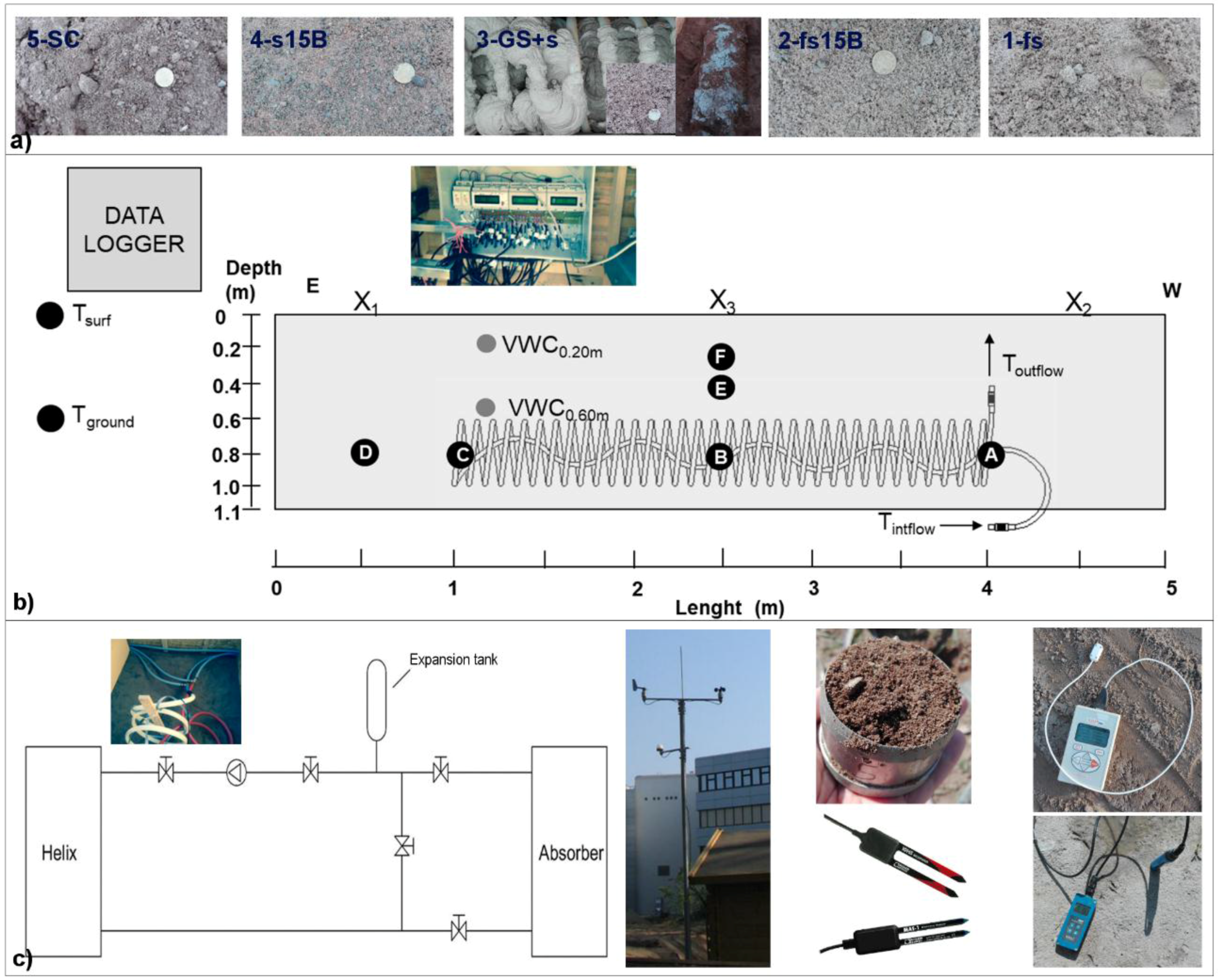
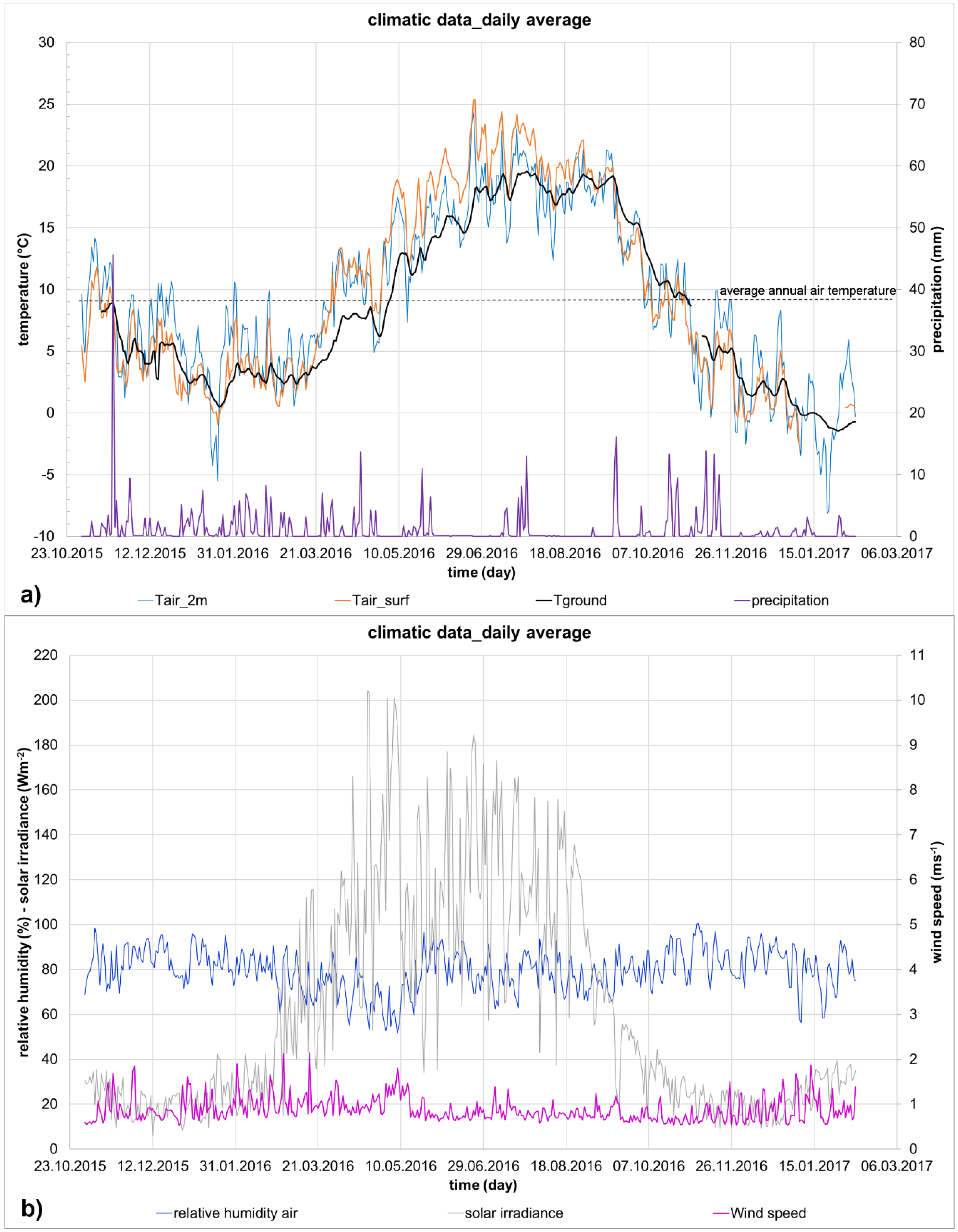
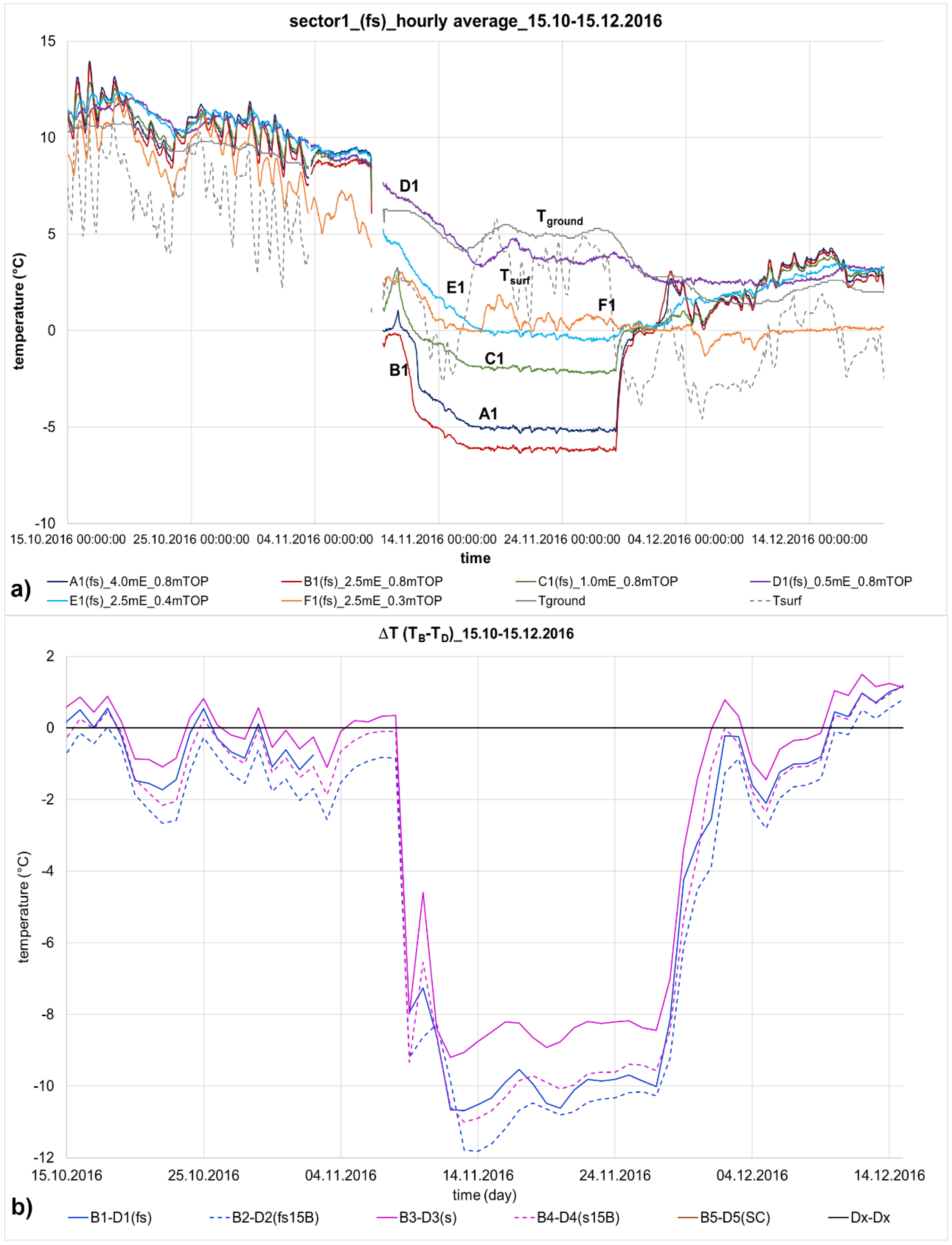
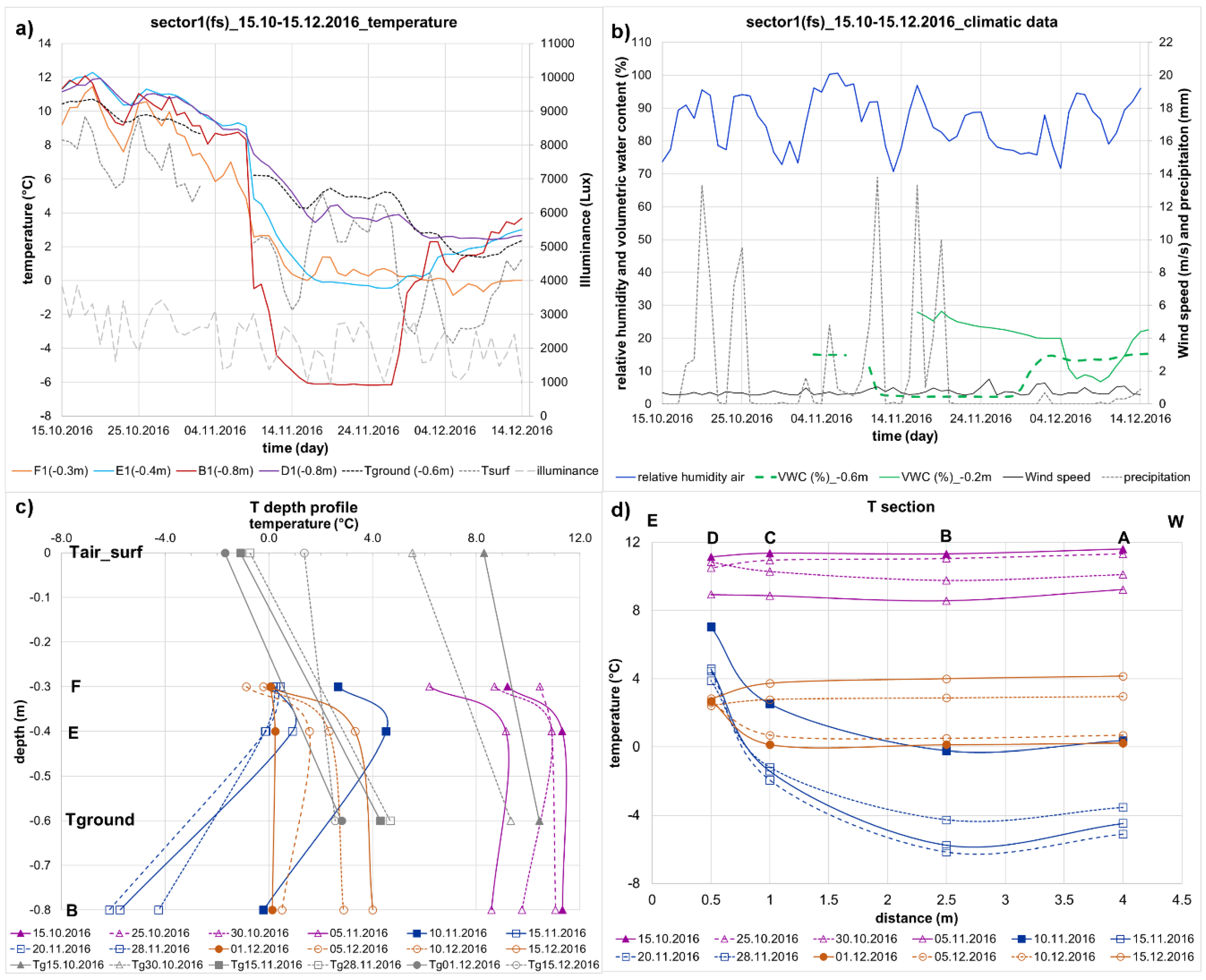
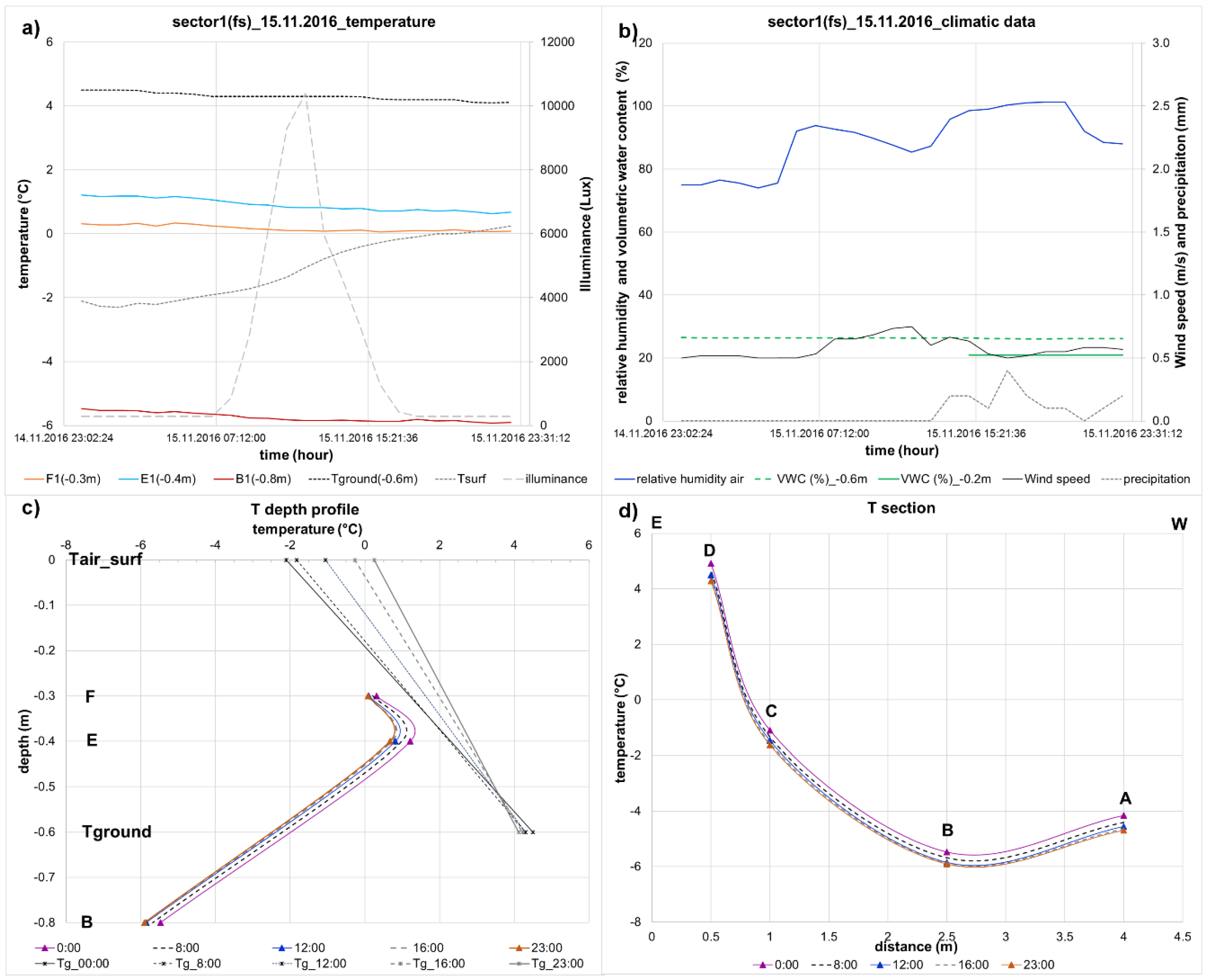

| Helix | Value |
|---|---|
| Spiral height—for transport (m) | 1.1 |
| Spiral height—for installation (m) | 3 |
| Outer diameter of the helix (m) | 0.40 |
| Pipe length (m) | 40 |
| Pipe size (mm) | 25 × 2.3 |
| Pipe Material | High density polyethylene (PE-Xa) |
| Pipe Outside diameter (mm) | 25.0 |
| Pipe Inside diameter (mm) | 20.4 |
| Total length of the helical pipe (m) | 40 |
| Pitch between the turns (m) | 0.10 |
| Weight (kg) | 7.5 |
| Volume (for water/antifreeze) (l) | 13 |
| Temperature resistance (°C) | up to 95 |
| Estimated average extraction performance (W/helix probe) * | 450 |
| Depth (m) | Sector 5_SC | Sector 4_s15B | Sector 3_GS+s | Sector 2_fs15B | Sector 1_fs |
|---|---|---|---|---|---|
| −0.20 | 19.6 | 15.9 | 5.3 | 28.4 | 14.1 |
| −0.60 | 10.1 | 12.8 | 10.8 | 26.7 | 6.6 |
© 2017 by the authors. Licensee MDPI, Basel, Switzerland. This article is an open access article distributed under the terms and conditions of the Creative Commons Attribution (CC BY) license (http://creativecommons.org/licenses/by/4.0/).
Share and Cite
Di Sipio, E.; Bertermann, D. Factors Influencing the Thermal Efficiency of Horizontal Ground Heat Exchangers. Energies 2017, 10, 1897. https://doi.org/10.3390/en10111897
Di Sipio E, Bertermann D. Factors Influencing the Thermal Efficiency of Horizontal Ground Heat Exchangers. Energies. 2017; 10(11):1897. https://doi.org/10.3390/en10111897
Chicago/Turabian StyleDi Sipio, Eloisa, and David Bertermann. 2017. "Factors Influencing the Thermal Efficiency of Horizontal Ground Heat Exchangers" Energies 10, no. 11: 1897. https://doi.org/10.3390/en10111897





